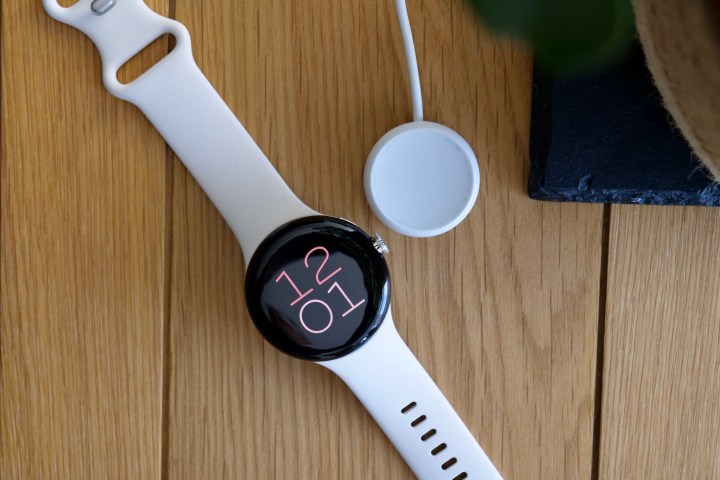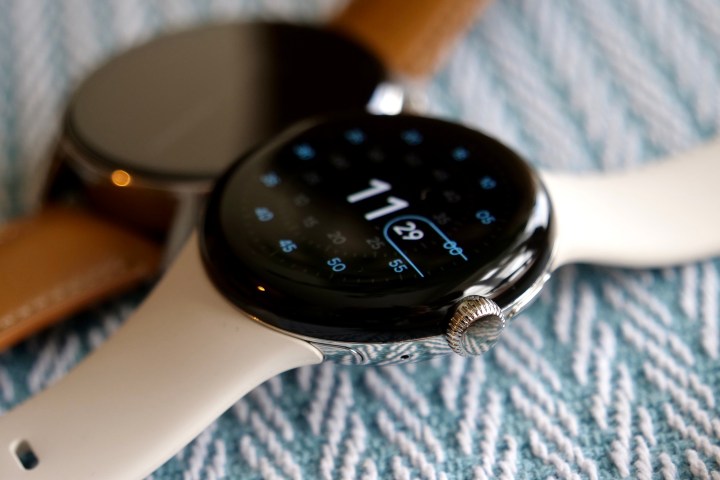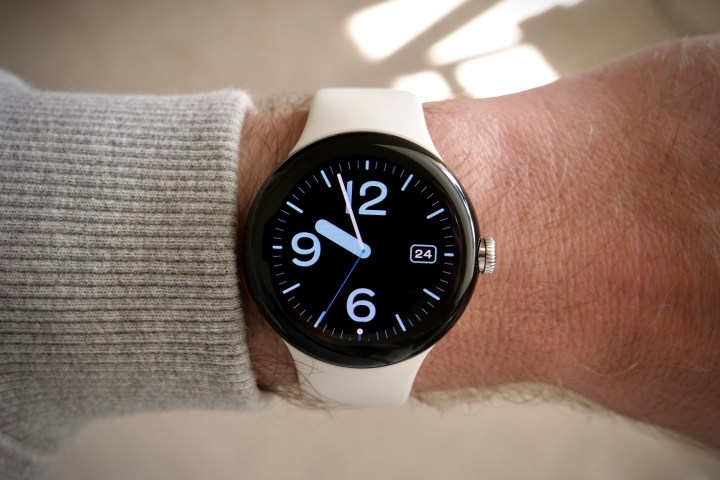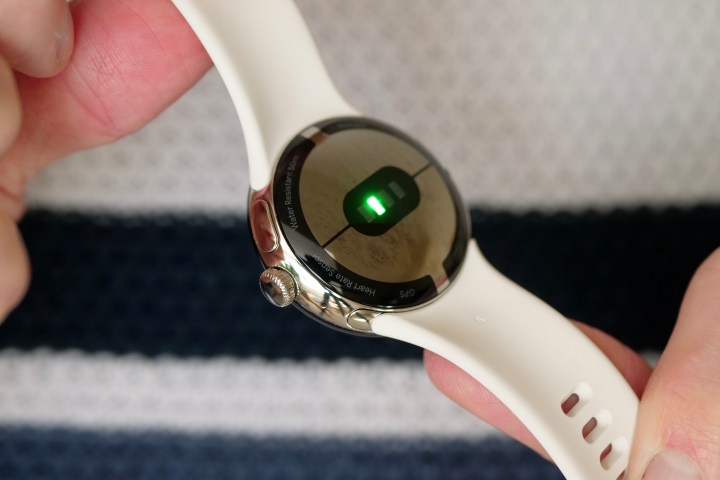Google’s first attempt at the smartwatch ecosystem was the Pixel Watch, which served fine hardware and rewarding software married to underwhelming battery life and some missing health-tracking features. It looks like Google will address all the damning foibles in one fell swoop later this year with the Pixel Watch 2.
According to 9to5Google, Google is switching away from Samsung’s Exynos processor fitted inside the Pixel Watch. Instead, the company is sourcing Qualcomm’s W5 series flagship smartwatch chip for the second-gen Pixel Watch. That’s great news — not just for the Pixel Watch legacy, but also for the whole ecosystem.
Announced last July, the Snapdragon W5 and its Plus version are based on the 4nm fabrication process, compared to the 10nm-based Exynos chip inside the Pixel Watch. That’s a huge jump, which theoretically promises dramatically improved raw firepower and increased energy efficiency.
Qualcomm says that compared to its own Snapdragon 4100+ smartwatch silicon, the W5 family offers a 2x boost in performance and also serves extras like always-sensing health awareness tricks, low-power ambient features, and allows a smaller device footprint.
Plus, the whole package also ships with a co-processor to offload less demanding or specialized tasks from the main processor. While more grunt under the hood is always welcome, the part about energy efficiency is more promising. Qualcomm has promised a 50% jump in generation-over-generation battery life with the Snapdragon W5 series.

The Pixel Watch has improved its battery life slightly with software-side optimizations, but it still can barely last over a day with continuous tracking, GPS enabled, and sleep monitoring enabled. The Snapdragon W5+ Gen 1-based Mobvoi TicWatch Pro 5 absolutely crushes the Pixel Watch, with my colleague Andy Boxall reporting up to four days of battery life with a similar usage pattern.
Now, it would be unwise to credit all those improvements to the Snapdragon silicon inside, but it’s hard to dismiss the sheer difference between the two smartwatches based on the same Wear OS platform.
It would be interesting to see how Google leverages the vastly superior. At least on paper, the Snapdragon W5 series chip inside the Pixel Watch 2 should finally deliver a smartwatch that can truly go toe-to-toe with the Apple Watch.
This bodes well for the entire Wear OS ecosystem

Wear OS stayed laggard for years, and it was only following the Tizen OS merger with Samsung about two years ago that development really picked up the pace. With the upcoming Wear OS 4 update, Google has announced not only a swath of new features but also deep performance optimizations that could very well translate to improved battery life.
But there’s another benefit of the Snapdragon W5 coming to the Pixel Watch 2. Save for Samsung, there’s no mainstream smartwatch brand in the Wear OS ecosystem. The likes of Fossil and Mobvoi have remained loyal to Snapdragon silicon for years, and soon, Google will join that league, too.
Now, Google is the maker of Wear OS, and it only comes naturally that with the Pixel Watch 2, the focus of tuning Wear OS will shift more towards Qualcomm than outliers like Exynos. In simple words, Google’s work on Wear OS with a Snapdragon chip as the test bed would naturally help every other smartwatch brand that has inked a deal with Qualcomm.

Yes, the Pixel family doesn’t really crack up the market with bombastic sales. But more than just a hardware endeavor struggling to rake in fat profits, the Pixel family has always served as the test bed for showcasing the best of Google’s hardware — be it Android or, at the moment, Wear OS.
I can’t wait to see what practical improvements arrive with the Pixel Watch 2 and how it could serve as a template to make even better Wear OS hardware from partner brands. Samsung, well, it looks like the upcoming Galaxy Watch 6 series will stick with a new Exynos process instead of embracing Qualcomm — despite doing so with the all-Snapdragon approach for the Galaxy S23 series phones.
Google wants to fill the feature gulf, too

In our Pixel Watch review, we classified the Pixel Watch as a “relatively simple fitness tracker.” It missed out on tricks like temperature sensing, body composition analysis, an abnormal heart rate detection system, and some odd activity tracking pitfalls.
Overall, Google didn’t really put in the effort to make it a standout fitness companion, despite charging a handsome $350 for it. But it looks like Google is ready to make amends with its second smartwatch outing. The 9to5Google report mentions that Google is borrowing the sensor array from the Fitbit Sense 2 smartwatch by Fitbit, a company that Google owns.
Assuming the report turns out to be true, we are looking at an Electrical sensor to measure skin conductance (cEDA) for stress detection on the Pixel Watch 2, alongside an on-wrist skin temperature sensor. We don’t know if Google is going to add any next-gen biosensing module to the Pixel Watch 2.
In terms of features, you can expect all-day body response tracking, improved sleep profiling, heart rate variability, skin temperature logging, high and low heart rate notifications, active zone details, and workout readiness scoring, among others.
Correcting the first Pixel Watch’s mistakes

“There’s no excuse for the Pixel Watch’s many downsides,” says our review of the Pixel Watch, adding that Google “failed to make the Apple Watch of the Android world.” Even months after launch, Google hasn’t really addressed those gloaring pitfalls, some of which are tied to the inherent hardware and can’t be addressed with software updates.
Plus, it definitely doesn’t help that more capable rivals that also offer a better deal at a lower asking price are already out there. It’s just pathetic that buyers have to pay a premium to live with a sub-par experience. But hey, this is a Pixel, after all, and where’s the legacy fun if Google doesn’t bomb and then chart a corrective course?
Overall, based on leaks, the Pixel Watch 2 is shaping up to be the Wear OS smartwatch that Google should have made in the first attempt. I’ll be more than happy to lap up the current design – and at the same premium price tag – if Google makes the tangible changes under the hood and delivers a better smartwatch package later this year.
Editors’ Recommendations
